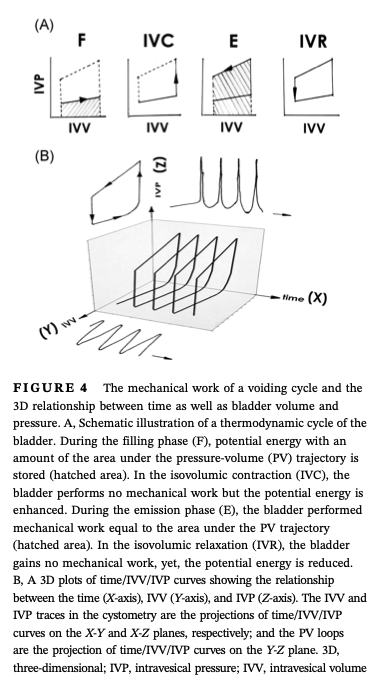研究主題:壓力體積分析法運用在分析膀胱排尿週期之可行性
撰寫:學生邱千容
在臨床上,泌尿科多用膀胱測量分析(Cystometry)去評估病患排尿時膀胱收縮的能力,其大致作法為放置導管至膀胱處後,將膀胱注滿生理食鹽水後要求患者進行排尿,在這當中記錄患者從何時感受到膀胱內有液體、感到膀胱壓迫,因其進行時間從十五分鐘到一個小時不等,所獲得的數據中也包含了時間的資訊。
而壓力與體積之關係分析(Pressure-volume analysis, PVA)更注重於探討腔室內壓力和體積之間的相互關係,此一分析方式已廣泛應用於分析心臟的動力學。透過結合膀胱測量分析的時間資訊,PVA有助於探討膀胱的排液動力學。
林則彬老師率領團隊使用動物模式[1] 以及人體臨床檢查 {[2,3]開發了透過PVA檢測膀胱功能方法,並以膀胱內的壓力和體積的相對關係進一步定義了排尿週期的不同階段;FIGURE 4中可以觀察到大約可分成四個階段,分別是Filling phase、Isovolumic contraction、Emission phase、Isovolumic relaxation。同時並檢測了PVA的信度及確度,證實PCA的確能有效地分析膀胱週期性的穩態及動態功能。

Research Topic:
Pressure-volume analysis(PCA) applies to bladder functional measurement
Cystometry, which involves catheterization of the urinary bladder, is widely used in clinical to analyze and assess the voiding function of the bladder. In this protocol, the bladder is filled with saline, and the patient is instructed to complete a void. As results of cystometry markedly includes temporal information, to specify the dynamic of voiding with minimal temporal would provide information about voiding dynamics of the bladder.
Pressure-volume analysis (PVA), which explores the relationship between pressure and volume, has been well established in the cardiology to study thermodynamic process of cardiac cycle; nevertheless, the potential application of PVA in the voiding dynamics has not been investigated.
Using animal study [1] and clinical investigations [2,3], professor Tzer-Bin Lin’s research team has developed protocol of PVA in assaying voiding dynamics. Moreover, using PVA, the voiding cycle has been defined as Filling, Isovolumic contraction, Emission, and Isovolumic relaxation based on the specific thermodynamic process. In the paper, the research team examined the reliability and validity of PVA and confirming the effectiveness of PVA in analyzing both steady-state and dynamic voiding functions.
[1] Peng, Hsien‐Yu et al. “Pressure‐volume Analysis of Rat’s Micturition Cycles in Vivo.” Neurourology and urodynamics 39.5 (2020): 1304–1312. Web. [2] Lau, Hui-Hsuan et al., “Pressure-Volume Loop Analysis of Voiding Workload: An Application in Trans-Vaginal Mesh-Repaired Pelvic Organ Prolapse Patients.” Bioengineering (Basel). 2023 Jul 19;10(7):853. [3] Lau, Hui-Hsuan et al., “Modification of bladder thermodynamics in stress urinary incontinence patients submitted to trans-obturator tape: A retrospective study based on urodynamic assessment.” Front Bioeng Biotechnol. 2022 Aug 19;10:912602.
